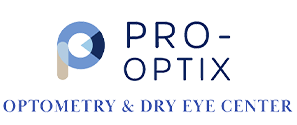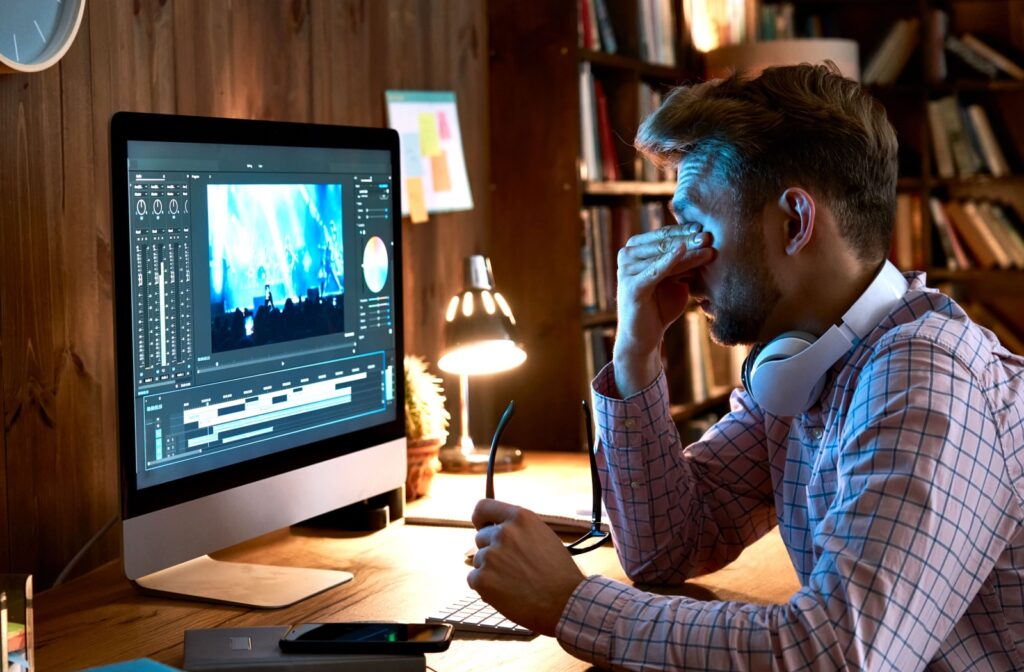Long hours of focus and productivity feel great in the moment, but for some people, symptoms like dry eyes, fatigue, and a pounding headache might accompany it.
Dry eye syndrome (or dry eyes) is a chronic eye condition that millions of Americans experience. Some days are more manageable than others, since factors like extensive screen time, living in dry places, or improper contact lens wear can aggravate ongoing symptoms.
Research shows that eye strain, which develops from long periods of focusing, especially in our screen-dominated world, can exacerbate dry eye symptoms and lead to tension headaches.
Fortunately, living with discomfort doesn’t have to be an everyday reality. A dry eye consultation with our ProOptix Eye Care team can help you find long-lasting relief from dry eyes while also helping you manage headaches.
Exploring the Link Between Dry Eyes & Headaches
Although dry eyes and headaches may seem like two entirely different conditions, they do have a connection beyond sharing symptoms like sensitivity to light, general discomfort, and soreness around the eyes.
If you’ve noticed a pattern where dry eyes and headaches tend to strike after hours of working, reading, or scrolling on digital screens, then it’s possible that both situations have the same underlying cause: eye strain.
Focusing might feel great for your mind, but it’s not so friendly to your eyes. Working for long periods likely means you’re blinking less, leading to a lack of proper distribution of tears to hydrate your eyes, which worsens tear evaporation.
A combination of dry eyes, screen glare, poor lighting, and long periods of focus can tire your eye muscles, eventually culminating in a headache.
As this discomfort persists and your eyes continue to be overworked, you might squint sometimes for better focus or make an active effort to blink more often to spread tears more evenly across your eyes. However, doing so also stresses the muscles of your face and eyes, thereby adding to your headache.
It also seems to be the case that dry eyes occur more often in people who experience chronic migraines.
Addressing this relationship can help you find immediate relief while supporting long-term eye health.
Adopting Preventative Measures
If headaches from dry eyes and eye strain are derailing your day, the good news is that preventative strategies can help!
You can alleviate symptoms before they develop or manage them with lifestyle and environmental adjustments:
- Adopt the 20-20-20 rule: This is one of the simplest ways to reduce eye strain. Every 20 minutes, take a 20-second break to look at something 20 feet away. This relaxes your eye muscles, reduces strain, and prevents tear evaporation.
- Improve your workspace: Position your screen about an arm’s length away and angled slightly below eye level. Use a glare filter to minimize screen glare and ensure your workspace is well-lit without harsh lighting. An ergonomic setup can go a long way in preventing dry eye symptoms and associated headaches.
- Blink more: Consciously remind yourself to blink, especially during long hours of screen use. Blinking helps replenish your tear film and prevents the drying effects of less tear coverage.
- Hydrate: Dehydration can worsen dry eye symptoms. Drink plenty of water, and support your tear film using artificial tears for added hydration. Using a humidifier can maintain better indoor air moisture, reducing tear evaporation.
Small habits really can make a difference!

Long-term Relief with Advanced Dry Eye Therapies
If preventative measures aren’t enough and your dry eyes continue to cause discomfort and headaches, it may be time to consult an optometrist.
With targeted dry eye treatments, we can identify the root cause of your symptoms and recommend treatments tailored specifically to you.
Some of the therapies we offer include:
OptiLight IPL (Intense Pulsed Light Therapy)
This treatment uses gentle pulses of light to heat the skin surrounding the eyes to reduce inflammation and improve oil production for a more stable tear film.
It’s especially effective for managing dry eye caused by meibomian gland dysfunction (MGD), a common underlying factor in persistent dry eye cases.
Stimulating natural oil production supports tear quality, encouraging tears to last longer and spread evenly on the eye’s surface, allowing you to focus without persistent discomfort.
OptiLIFT
OptiLIFT works to address lower eyelid laxity and impaired blinking, which can both contribute to an overall feeling of dryness in the eye.
This treatment uses electrical pulses to activate and tone the periorbital muscles to enhance the function and appearance of the eyelid.
Punctal Plugs
Punctal plugs are a simple solution for people with dry eyes caused by excessive tear drainage. Tiny biocompatible devices are placed in the tear ducts to slow drainage so that tears stay longer on the surface of the eye, thereby offering better hydration.
LipiFlow
Similar to OptiLight, LipiFlow uses thermal pulsation to apply gentle heat and pressure to the eyelids, unblocking and restoring meibomian gland function.
Improving these glands’ oil flow prevents tears from evaporating too quickly from the eye’s surface, while also offering lasting relief from dry eye symptoms.
Prescription Eye Drops
Sometimes, over-the-counter artificial tears aren’t enough.
Prescription eye drops, tailored to target your dry eye’s underlying condition, can offer long-lasting relief. These drops can treat inflammation, improve tear quality, or address specific allergies, helping to balance the tear film.
Experience Lasting Relief
Sometimes, managing your daily schedule is enough of a headache. Don’t let your dry eyes distract you for long. The road to long-term relief from dry eyes and subsequent headaches is closer than you think. Connect with our ProOptix Eye Care team to schedule your dry eye consultation. Together, we can tailor a treatment plan to meet your unique needs.





